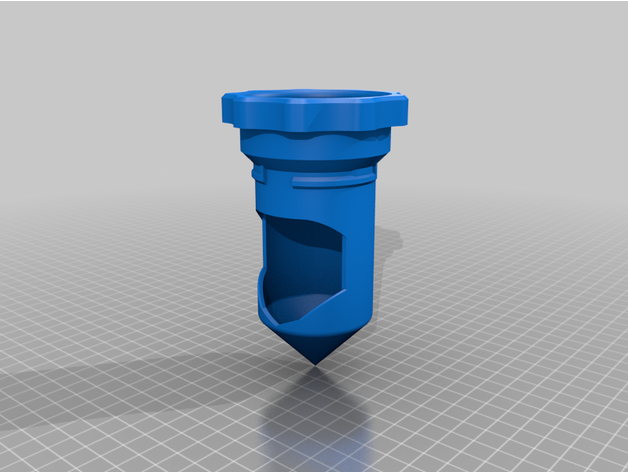TFro3
Gardening Enthusiast
Staff member
DIY Aeroponic Tower Supporter
Aeroponic Assembly Guide Supporter
- Growing Zone
- 7a (US)
DIY Aeroponic Grow Tower Your Way
Welcome fellow Tower Builders!
We are thrilled to introduce you to our exclusive DIY Aeroponic Tower section, where your aeroponic gardening journey takes on a whole new dimension. As a premium member, you have unlocked a world of possibilities, allowing you to harness the power of 3D printing and build your very own custom aeroponic towers.
We would like to express our sincere gratitude for your support and commitment to urban hydroponics and aeroponics!
What sets this section apart is the access to a vast collection of 3D printer STL files. These files enable you to create intricate and customized components for your aeroponic towers using a 3D printer. From unique tower designs to specialized fittings and connectors, the possibilities are endless.
To complement the 3D printer STL files, we provide a comprehensive parts list, ensuring you have all the necessary components to bring your vision to life. Whether it's sourcing the perfect water pump, spray nozzles, or tubing, we have carefully curated a list of high-quality items that align with the specifications of your chosen 3D printed design.
But we don't stop there. We understand that embarking on a DIY project can sometimes be daunting, especially for those new to the world of 3D printing and aeroponic systems. That's why we have also prepared an easy-to-follow assembly guide that walks you through each step of the building process. This guide serves as your trusted companion, offering clear instructions, helpful tips, and troubleshooting advice to ensure your success.
We encourage you to embrace your creativity and let your imagination soar as you explore the possibilities of 3D printing your own aeroponic towers. Customize your designs, experiment with different configurations, and share your creations with the community. The joy of seeing your vision materialize into a fully functional and aesthetically pleasing aeroponic tower is immeasurable.
Thank you once again for your support, trust, and enthusiasm. We are honored to be part of your journey as you embark on this exciting DIY adventure. Should you have any questions, feedback, or ideas to share, our dedicated support team is here to assist you every step of the way.
Get ready to unlock your creativity, build a sustainable future, and make a lasting impact with your own 3D printed aeroponic towers.
Happy building!
Parts/Shopping List:
- 4” PVC (schedule 40) Pipe (Make O.D. measures 4.5”) in whatever height you want - I did 5’
- You may see a thin walled option that is cheaper. GET THE THICK WALLED!
- ½” schedule 40 PVC pipe in same height as 4”
- ½” schedule 40 PVC coupler (to glue at one end so it will allow pipe to hang from the water distribution piece/part.
- ½”” adapter for water pump line.
- Water pump (make sure to get one that has a lift rating at tall as your tower or else the water wont pump to the top)
- Amazon Link for a 2 Pack! Current price of ~$30 makes each pump $15 which not only is a great price but is ALWAYS good to have a spare in case your pump goes out. Once a pump stops working you only have a matter of a hour or so before plants start to suffer! Not to mention you can use the second pump to transfer nutrient water into your tower bucket(s) easily!
- M4 screws (or similar) with washers and nuts (to attach pipe flange to bucket lid)
- Phillips screws (stainless steel) number 6 x ½” (to attach pod holders, bucket flange to PVC pipe, aeroponic top to 4” PVC, and tube support part inside the 4” PVC pipe.)
- Food safe bucket - I got a 5gal from Lowes
- 100% Silicone - Clear (to make top, flange, and all pod holders water tight)
- 2 ⅛” (54mm) Hole Saw
- 5” (127mm)Hole Saw
- Hole Saw Set from Harbor Freight works great! This set comes with both sizes needed for this build!
- Heres also an Amazon Link if you don't have a Harbor Freight close!
- 2” x 2 ¾” Net Cups
- Amazon Link ) for 100 net cups that I purchased. It's good to have extra's on hand for future builds, replacements as they break, and starting new seeds when currently plants are nearing the end of their life so you can rotate plants in and out to shorten the seed to harvest timeframe!
- 1x Top Cap Bolt (printed with 20% infill)
- 1x Top Cap (printed with 20% infill)
- 1x Water Distributor (printed with 20% infill)
- 1x Tube Support (printed with 20% infill)
- 1x Pipe Flange (printed with 40-50% infill)
- Net Cup Holders (printed with 100% infill) (However many you want)
- Net Cup Cap (printed with 20% infill) (As needed when you don’t have plants in all net cup holders)
Printing all the parts is really straight forward. No supports are needed on any of the parts. Print the net cup holders vertically with Brim to make sure proper adhesion to the build plate (see image below)
The rest of the settings will depend on what printer you have and what brand PETG you’re printing with.
Using your 5” (127 mm hole saw), drill a hole in the center of your bucket’s lid, as shown below.
Test fit your bucket flange in the hole.
Insert your 4” PVC pipe into the flange so the flange is higher on the PVC than the height of the bucket.
Now insert the PVC pipe into the bucket through the hole in the lid. With the PVC pipe at the bottom of the bucket, push the flange down the PVC pipe until it presses firming against the bucket’s lid. (This is a very important step to make sure the PVC pipe is at the bottom of the bucket because this is what provides the tower support from being wobbly.)
Remove the PVC pipe from the bucket and mark the flange location with a marker.
If the bucket lid you chose is white or another light color, it will be a really good idea to paint it black to help limit the amount of light coming into the water reservoir. When light comes into this bucket it can increase the changes of algae growth.
Once dry, put the lid back on the bucket and insert the PVC pipe with the flange to help keep it sturdy. Then figure out how you want to space out your net cup holders and dry fit them by securing them with the screws. (DO NOT OVERTIGHTEN SCREWS! Screws that are too tight will crack the net cup holders that took a long time to print!) Once everything looks the way you want, take your marker and trace the inside of each net cup holder.
Once all net cup holders are traced, remove all the net cup holders from the tower.
Using your 2 ⅛” (54mm) hole saw, start by drilling in the center of the circle with the drill bit.
Once drill bit has penetrated the PVC pipe, drill the hole saw at a roughly 45 degree angle. This will help ensure the net cups will move freely in and out of the tower.
Using a razor or box cutter, ream the excess from the hole to clean it up.
Flip the tower upside down and drill holes all over below the flange. This will allow water to easily flow back into the reservoir.
Now take your tube support and insert it into the PVC pipe, and secure it by running screws through the pipe into the support, as shown below. At this point you can also secure the flange to the PVC with the screws.
Now open your tube of 100% silicone. Apply a generous amount on the bottom side of the flange and insert the pipe into the bucket’s lid. Firming pressing it down, you should see silicone coming out from under the flange. This will ensure we have enough silicone applied.
Secure the flange with the nuts, bolts, and washers. Bolts should be tight but remember to not overtighten as this could crack the PETG flange. Once secure, using your finger and a paper towel/rag wipe off the excess silicone.
Now apply a generous amount of silicone around the net cup hole.
Press the net cup holder firmly against the PVC pipe. The silicone will hold it in place. Next get your screws and secure the holder to the PVC pipe as you did when tracing the holders.
Repeat this for all net cup holders, wiping the excess silicone off as you go.
Insert the ½” PVC into the tower and attach the adapter you chose for the water pump hose. Pictured below is a 3D printed one that actually failed so I got an adapter from my local hardware store instead.
Now apply a bead of silicone at the top of the tower and place your water distributor cap on top of the bead. No worries about cleaning this excess up as we will be applying more when putting the top cap on the tower!
Slide the ½” PCV pipe up through the water distributor and put on the ½” PCV coupler. You can use PCV glue or simple run a screw through it so it doesn’t fall out.
Next apply another generous bead of silicone around the bottom of the top cap for the tower. Then insert it on the PVC pipe until it comes in contact with the stoppers. Secure the top with 2 screws.
That’s it! Now wait the recommended amount of time needed for your silicone to set up as indicated on the tube. Mine was 24 hours of dry time.
After that transfer your seedlings into the tower, setup your time and watch your plants grow!
*I put my food grade bucket into another darker bucket to limit light exposure
EDITS:
7/18/23 - Added the v2 net cup holder file
10/4/23 - All files have been removed from this post in order to maintain one source which has been uploaded to the "Customizable Aeroponic/Hydroponic Tower" project on Printables.com

